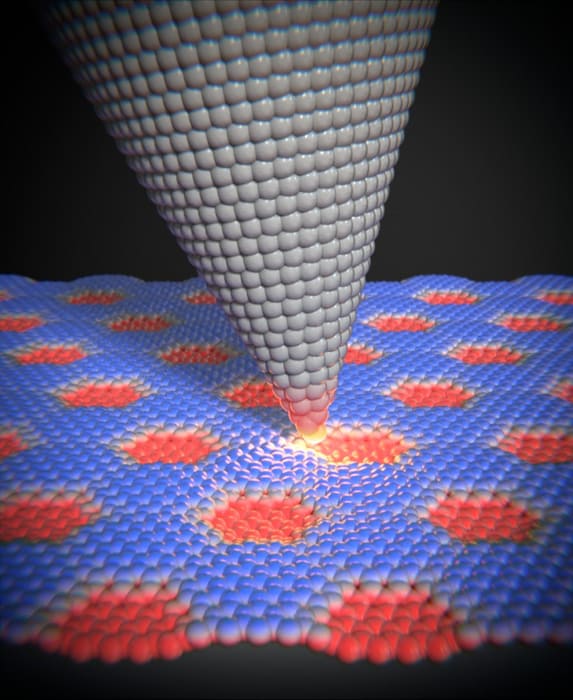Friction at the microscale depends unexpectedly on sliding speed
02 Feb 2023 Isabelle Dumé
Speed-dependent friction. (Courtesy: Department of Physics, University of Basel and Scixel)
Friction at the atomic scale appears to depend on the speed at which two surfaces move past each other. This surprising behaviour was observed as the tip of an atomic force microscope (AFM) moves along a graphene coating, and researchers at the universities of Basel in Switzerland and Tel Aviv in Israel say it results from surface corrugation induced by a mismatch in graphene’s lattice structure. The finding, together with observations that the frictional force scales differently in different velocity regimes, could have applications in devices such as hard disks and moving components in satellites or space telescopes that require ultralow friction.
In everyday, macroscopic objects, friction is either independent of the sliding speed (according to Coulomb’s law) or linearly dependent on it (for example in viscous media). On the atomic scale however, things are different. In the new work, a team led Ernst Meyer from the Swiss Nanoscience Institute and the Department of Physics at Basel University measured the speed at which an atomic force microscope (AFM) moves across a layer of graphene (a 2D form of carbon atoms arranged in a honeycomb-like configuration) atop a platinum substrate.
Moiré superlattices
In their experiment, which they report in Nano Letters, Meyer and colleagues found that graphene forms superstructures known as moiré superlattices. These structures are no longer completely flat, and the friction they produce scales in various ways depending on the velocity regime.
According to atomistic molecular dynamic simulations by Oded Hod and Michael Urbakh’s research groups in Tel Aviv, the mechanism behind the effect comes from deformation at the ridges of the moiré superlattice as the tip of the AFM moves along the graphene/platinum interface. The tip induces elastic deformation as it pushes on the ridge, followed by ridge relaxation upon detachment from the tip as it slides forward.
At low AFM scanning velocities, the friction force is small and remains constant (reminiscent of macroscopic behaviour), explains Hod. Above a certain threshold velocity, however, it increases logarithmically. “This threshold is lower the larger the size of the moiré superstructure, allowing to tune the cross-over value via the interfacial twist angle,” Hod says.
“A clear message for practical applications”
“Our findings provide a clear message for practical applications,” Urbakh adds. “To achieve ultralow friction using two-dimensional material coatings, they should be prepared in a way to produce small-scale moiré patterns.”READ MORE

The researchers say the mechanism they observed may also be relevant for polycrystalline materials, in which grain boundaries are present. They plan to study these in more detail in future work. “In this case, frictional energy dissipation is dominated by the contribution of the grain boundaries,” Hod tells Physics World. “We intend to find ways to eliminate grain boundary friction, for example by exploring unique negative friction coefficient regimes, where friction reduces with external normal loads, in contrast to common physical intuition.”

Isabelle Dumé is a contributing editor to Physics World
FROM PHYSICSWORLD.COM 16/3/2023

Δεν υπάρχουν σχόλια:
Δημοσίευση σχολίου